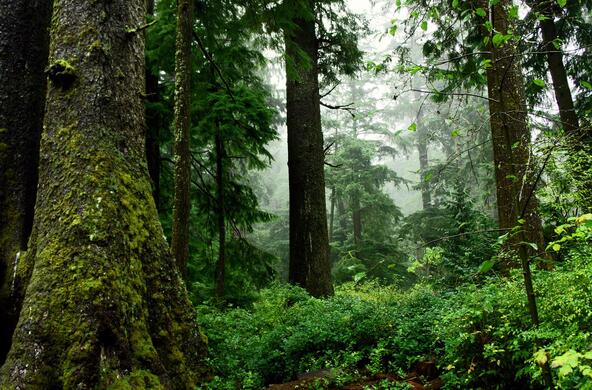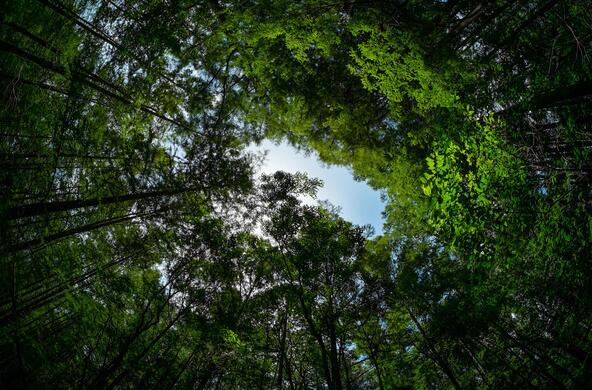Lakes around the world are getting warmer, which is bad news for cold water fish species and freshwater quality. This is because changes in water temperature shift in-lake processes that can affect the health of the system. Understanding how lake temperature is changing, and how these changes influence lake functioning, is key to maintaining healthy lakes into the future.
In a new study, published today in Geophysical Research Letters, Cary Postdoctoral Associate Isabella Oleksy and co-author David Richardson, a Biology Professor at SUNY New Paltz, analyzed 35-years of temperature data for Mohonk Lake, a small headwater lake on New York’s Shawangunk Ridge. They found that lake stratification is getting longer and stronger due to climate change, and year to year variability in lake mixing is associated with global climate trends.
Here, lead author, Dr. Isabella Oleksy, discusses the importance of lake mixing, what a longer stratified period means for lake processes, and how global climate patterns affect Mohonk Lake.
What is lake stratification?
If you've ever jumped into a lake, you’ll know the feeling of plunging through the water column. Suddenly you hit a layer of cold water – that switch from warm to cold is lake stratification. Cold water is more dense than warm water, so cold water sinks to the bottom of lakes. This creates an invisible divide that prevents chemical mixing in the lake. Layers of different temperatures contain different concentrations of nutrients and oxygen; these conditions give rise to distinct habitats and determine where lake organisms can live, find food, and reproduce.

What is lake mixing and why is it important?
Lakes in northern temperate regions (approximately Pennsylvania to Maine on the eastern coast of the US) typically mix twice each year, once in the fall then again in the spring. This happens when water temperature begins to equalize throughout the lake, and the warm surface layer mixes with cooler waters below. When this happens, new oxygen circulates through the water column. Nutrients are also able to mix. This process helps keep the whole lake habitable for a variety of organisms. Understanding effects of stratification on aquatic animals and water quality can help us manage things like fish kills and harmful algal blooms.
When a lake remains stratified for longer periods of time, the lower layers become oxygen-depleted, or ‘anoxic’. This is because lake bottoms are home to microbial decomposers that use oxygen when they break down dead plants and animals. Water that is low in oxygen can concentrate at the bottom of the lake, making it deadly for lake organisms. When animals move higher up the water column for oxygen, they find themselves in crowded, unsuitable habitat. Many fish, for example, can only survive in a narrow temperature range. Shifting into warmer waters near the surface is not a long-term solution and could lead to die-offs.
Another growing concern is a phenomenon called ‘internal phosphorous loading’. This is when low-oxygen conditions trigger the release of phosphorous that would typically be trapped in sediments in the bottom of the lake. Once released, this phosphorous fuels algae. This can become especially problematic in warmer, unmixed water – a perfect breeding ground for toxic algal blooms.
How can we use information on stratification and mixing to guide lake management?
Mohonk Lake is unusual in that it has a robust long-term record, so we have a clear picture of how stratification timing, strength, and mixing patterns are changing. We can use this record, together with data from other studied lakes, to predict what is happening in lakes that do not have long-term records.
Warming lakes will be bad for certain fish, especially temperature-sensitive species like trout which need cold water to survive. Understanding what warming means for fish success could guide decisions about what species of fish to stock, or whether it might be helpful to install an oxygen pump in a warming lake to head-off anoxia and expand available fish habitat.
Lakes are continually changing in response to local and regional climate drivers. We cannot assume that what worked 30 years ago is going to work today. We must adapt management actions to be resilient and responsive.

How is water temperature measured at Mohonk Lake?
Data collection started in the early 1980s with Dan Smiley, part of the family that still owns and operates the Mohonk Mountain House. Later, the Mohonk Preserve took over data collection and worked in partnership with community scientists to continue the legacy that Dan Smiley started. Dr. Richardson has been helping with the data collection for about a decade now.
The water temperature at Mohonk Lake has been recorded every week of the year for 35+ years. To measure temperature changes through the water column, they lower a temperature sensor through a hatch in a wharf that reaches out above the deepest part of the lake. This is the same wharf where Mohonk Mountain House guests can rent rowboats or canoes for recreation. They record temperature at 1-meter intervals from the surface to the bottom of the lake which is about 12 meters (~39 feet) at that location. There are several ways to assess lake stratification using these measurements.
How did you measure lake stratification in this study?
We developed a new metric called ‘mixing action’ which quantifies the total amount of energy that would be required to mix a lake over the stratified period. A higher number means the lake is more strongly stratified; it would take more energy for the warm and cold layers to ‘flip’. ‘Mixing action’ is a robust indicator of changing lake stratification because it integrates many different aspects of stratification – like timing, peak, and strength – all in one number.
In this work, you connected Mohonk Lake’s temperature record to the North Atlantic Oscillation, which influences climate on a continental scale. How do the two relate?
The North Atlantic Oscillation (NAO) is a cross-continent fluctuation of atmospheric pressure that affects winter and spring weather in much of the northern hemisphere. The NAO can cycle on a yearly or decadal basis, ‘oscillating’ between periods of low and high pressure across the areas that it affects. We are seeing that Mohonk Lake responds to NAO fluctuations in a very consistent way. Looking at NAO data, you could predict, for example, that the Northeastern US will have a colder, wetter spring. For Mohonk Lake, this would indicate that stratification would likely set up later in the spring.
In this study, we quantified stratification trends over 35 years. Within prevailing trends of warming and longer and stronger stratification periods, there’s also year to year variability. We found that some of this ‘noise’ in the data can be explained by oscillations in ocean circulation patterns. It is clear that what's happening out in the Northern Atlantic is affecting this little lake up on a ridge in New York. It's always really cool when you can tie local processes to a global climate system.
What were your top findings in this study?
Mohonk Lake is responding to global-scale climate drivers, as well as variations in local weather conditions. Lake stratification is increasing in length and strength, driven by climate change and exacerbated by fluctuations in the North Atlantic Oscillation. Locally, we found that air temperature affected surface water warming. We also found that spring conditions, influenced by the NAO, regulated deep water cooling in the summer. As the stratification period lengthens, it is possible that sometime in the not-so-distant future, mixing might happen only once instead of twice per year.

What are your next steps?
This study focused on what's happening between spring and fall. Our next step is to look at what is happening in the winter and how that might influence spring conditions. We are also interested in how fall conditions influence the timing of ice-on, which is when the lake is fully covered in a layer of ice that does not melt until spring.
Ice cover duration is getting shorter and our preliminary analyses indicate that this is driven by warming fall temperatures and later ice-on. Here, we found that turnover is happening later in the fall. We want to determine whether the timing of turnover influences when ice-on happens in Mohonk Lake. On the other side of winter, spring stratification tends to set up shortly after ice-off. We want to see how winter conditions impact spring and summer stratification dynamics, and how late-summer trends influence stratification set up in the fall.
There is so much happening in lakes in the winter that we are just beginning to understand. For example, lakes can develop a ‘reverse stratification’ when covered in ice but not snow. As sunlight shines through the ice, a layer of warm water forms beneath the ice. This could cause earlier ice-off. Snow-covered lakes would not experience this.
Lakes with clear ice and no snow cover can also be massively productive in winter. Sunlight penetrating the ice allows photosynthesis to continue; algae can bloom in the bright, windless conditions of a stable water column.
In recent years, we are also seeing that many lakes in the Northeast aren’t freezing at all. This could impact whether lakes will stratify and mix twice a year.
There’s a growing push to understand lakes in winter. Climate change is causing lake processes to shift rapidly in many areas, especially in the Northeastern US where we tend to be on the ‘edge’ of receiving rain or snow. We might lose ice altogether. Without studying winter lake processes, we won’t know how ice affects lake ecosystems and what we stand to lose. I'm excited to see what we can learn about the summer by studying the winter.
Citation
Oleksy, I. A., & Richardson, D. C. (2021). Climate change and teleconnections amplify lake stratification with differential local controls of surface water warming and deep water cooling. Geophysical Research Letters, 48, e2020GL090959. https://doi.org/10.1029/2020GL090959






